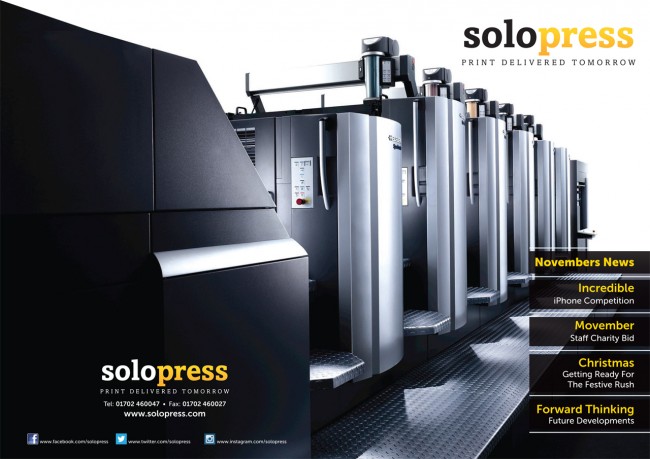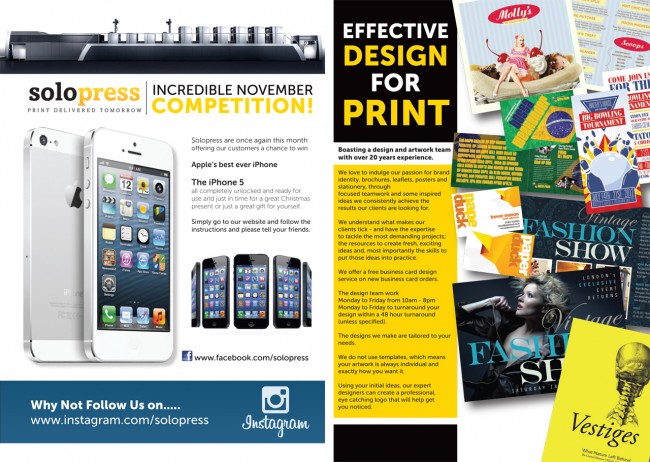Want to design a great looking brochure for your business or organisation? Then follow this in-depth guide by Solopress’ expert designer Julie Simpkins…
Think of your company brochure as a book that tells a story about your company’s products or services. Like any good story, it should have a clear beginning, middle and end – a front cover, inside pages and back cover. Before you even begin the design process, first take the time to really think about the information you want to include in your brochure. Create a brochure that is easy to read and interesting to look at, and you’ll be telling your company’s story in the best way possible.
Cover Star
The first page your customer will see is the cover. Motivate them to look inside. The front cover of your brochure must contain a strong selling message, and convince the reader to flip open your brochure. Make good use of a company logo to help emphasis your brand. Try not to overload the page, keep it light and airy so the customer wants to read on. A strapline is another option to entice the reader to want to find out more. If you are stuck for inspiration, take a look at the magazine covers in your local newsagent or online.
It’s Only Words
Use short sections broken up with a headline and a subhead. This will invite your potential customer to read on. Most readers will only read headlines, subheads and captions at first. These must give the benefits and the motivation so that the reader will want to read the rest of the text (also referred to as copy). Crowded text is hard to read so use white space in your brochure design. Stick to two typefaces, and strictly limit your use of bold, capitalization, underline, etc. By emphasizing everything, you emphasize nothing. Keep the font layout simple in your brochure design. As mentioned just now, don’t be afraid of white space. Cramming in too much information can be confusing to the reader and counter-productive. White space will also help emphasise what is included there on the brochure page.
Altered Images
Pictures really are worth a thousand words in any design, not just brochures. The fastest way you can show readers what your business or organisation offers them is by using images. Use high quality photographs of your products, or people using your products or services. The next piece is advice is really important and shouldn’t be ignored by any designer. Just because it looks great on the screen, doesn’t necessarily mean a photo or graphic image will look anywhere near as sharp on the printed page of your brochure. This is a common mistake made by many people, even professionals. If the resolution of your images is too low, the final result may look blurry when they’re eventually printed. Most images viewed on a computer monitor are automatically set at 72dpi (dots-per-inch). Make sure every image that goes off to printing is at least 300dpi in resolution to ensure the best results. Likewise, for printing purposes make sure that all of the imagery adheres to the CMYK colour process rather than RGB. If you don’t, the commercial printer will have to convert these images for you and this may mean the images look different to what you originally envisioned. Our Printing Buyers Guide has more details on this, and all other aspects of promotional printing, if you wish to find out more.
Stocky
A brochure with a heavier stock cover than the inside pages always has the feel of quality, but this is not essential. Additionally, applying a gloss or matt lamination to your brochure’s cover can give it a shinier or classier appearance. If environmentally friendly printing is of particular importance to your company or clients, then choosing a pulp stock that’s made from recycled paper is the ideal option. It’s worth mentioning on that back page of your brochure that it is entirely made from 100% recycled paper, giving your customers that extra little bit of reassurance about your company’s eco values.
Shapely
Using your imagination when designing your brochure can attract more attention. If applied in the right way, it’ll help provide a far better engagement for any person reading it. A conservative brochure design is boring and probably won’t yield the excitement and curiosity about your business that you’re hoping for. For starters, your brochure doesn’t necessarily have to be the standard A4 size and magazine shape. Smaller brochures can fit in the pocket, while larger ones will instantly look and feel more substantial and inviting to read. Why not alter the shape as well? Simply ask your commercial printer if they offer a die or laser cutting print finishing service, with this you’ll be able to create brochures with unusual and memorable shapes. Like an amazing looking business card, a truly creative brochure is a great conversation starter.
Foldy
If your brochure only consists of a few pages, you could try a single fold, tri-fold or concertina fold to present the content in a quick and easy fashion. A folded brochure design is great for takeaway menus, tourist information, healthcare tips and other similar marketing materials.
Make Contact
Your contact details are a vital piece of information to include in any brochure. This is generally placed on the back page. Make sure that in your brochure the reader can find things like your company name, logo, address, telephone number, fax, e-mail and web address. You may find that social media is increasingly important to your readers too, so add all the popular ones like Facebook, Twitter, YouTube and LinkedIn if your business or organisation has a presence on there. Don’t forget to also give directions to your location in the real world, along with your office or store opening times, if customers or clients need to come to you.
Proof It
Have you – and your work colleagues – checked that all the spelling, images and information in your company brochure is 100% correct? There’s no point having a beautifully designed brochure with the wrong telephone number or any other glaring mistakes in it! People pass these things along, so make sure that all of your contact info or promotional deals are correct.








Sweet 🙂
Your style is very unique in comparison to other folks I have read from on their blog. I appreciate you for posting when you’ve got the opportunity, I like your style or writing. thank you.
I have to thank you for the efforts you have put in penning this site. I really hope to see the same high-grade blog posts by you in the future as well. In truth, your creative writing abilities has encouraged me to get my own website now 😉
Good info. Lucky me I came across your site by chance (stumbleupon). I’ve book marked it for later!
A really interesting post, has certainly given me some ideas for my menus and takeaway flyers.
Comments are closed.